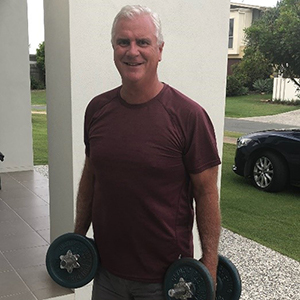I am stronger now than I was before my stroke
By Greg Crawford
In July 2017, I woke up during the night with the feeling gravity was pinning me to the bed.
I managed to get up and shuffle to the bathroom before waking my wife. My left side didn’t seem to be responding as it should. We’re both familiar with the F.A.S.T (Face. Arms. Speech. Time) signs of stroke so when we switched on the light and saw there was no change to my face, we went back to bed. We hoped whatever was going on would sort itself out by the morning.
However, the next day things were clearly not right so we went to hospital. I was assessed by the stroke team and had a scan of my brain. My scan didn’t show anything and my symptoms were deemed to be related to a virus, so I went home.
Back home, I nearly fell over in the driveway as my leg failed to step out of the car. I still had movement in my left limbs, but they were reacting slowly. I couldn’t walk unaided. I needed assistance getting into the house and getting into bed, where I stayed until the next morning. By then, the situation had worsened and I went back to hospital in an ambulance.
I was assessed again and had another brain scan. This time the doctor saw a stroke.
I had been diagnosed with an irregular heartbeat nine years earlier when I was 47. My cardiologist, at the time, conducted a treadmill test and echo test. She concluded that my heart was strong and my arteries were clear. I was otherwise well, so I was told not to worry and enjoy life.
The doctors in the hospital detected my heart irregularity and said I had atrial fibrillation (AF), and that is what caused my stroke. According to the Stroke Foundation, atrial fibrillation affects more than 400,000 Australians and many of those people don’t even know. People with AF are five times more likely to have a stroke.
My occupational therapist put everything in context. She said my white blood cells were stripping away the dead brain cells and other cells were taking on the job of that part of my brain. But these cells needed to learn, so the more I did or tried to do, the better chance they would have of establishing new pathways for messaging to the rest of my body.
This made sense to me so I kicked into gear – well, not quite ‘kicked’ but motioned at least. My left side was impacted so I started working on it. I ordered a banana with breakfast each morning and spent a few hours holding and twirling it in my left hand until I got sick of it and ate the sucker. I worked out I could use the bed rail as a makeshift tricep lifting machine to strengthen my left arm, until the nursing staff caught me. They thought l might break the bed so they brought in some dumbbells. I did other exercises as well and noticed the more l did, the more movement was coming back. I was excited to wake up and see what my brain had learnt the day before and how it would respond today.
After a week, I moved to a rehabilitation hospital where I did occupational therapy and two physiotherapy sessions each day. I was determined to improve, and I did my own workouts in between. I was told I would be there for up to four weeks, but was discharged after two weeks. I wanted to stay longer because I felt there was more improvement I could make, but I was sent home and continued as an outpatient.
Once I was home, I had a garage gym I began working out in and also hit the local gym every day focusing on what I could turn this new body of mine into.
On my first day back at the gym, I picked up 12 kilogram dumbbells in each arm, which is what l used before the stroke. The first few days were pathetic attempts to use these weights, but I persisted. Amazingly the strength came back fairly quickly and I now use 17 kilo dumbbells.
I took an initial three months off work as a home loan specialist to rebuild my body, then another three months to try and build brain endurance as brain fatigue would hit and it would hit hard. When I was able, I’d go to the gym as l found the blood flow and endorphins would give the brain fatigue a run for its money and replace it with muscular fatigue – which was much nicer.
I couldn’t have done any of this without the love and support of my family. They were my cheer squad. My wife was my rock and my recovery journey has inspired each of them to some degree in different ways.
Emotionally, I never felt upset or depressed. I had a pretty simple approach to my situation – I had lived 55 great years, married a wonderful woman and we had raised great kids. My life to me was a book – I didn’t write it; it was written for me and I have no idea how many chapters are in my book. No-one does.
The reason I wanted to share my story was partly to highlight that not all the F.A.S.T factors need to be present when a stroke occurs. But more importantly, stroke doesn’t mean your life is over. The human body is an amazing thing and the recovery journey I’ve been on has shown me what it is capable of doing.
Although it has taken time, my journey has been exciting in many ways as l watched my left side become operational again. I am actually stronger now than l was pre-stroke. I have also returned to work – all that within eight months.

